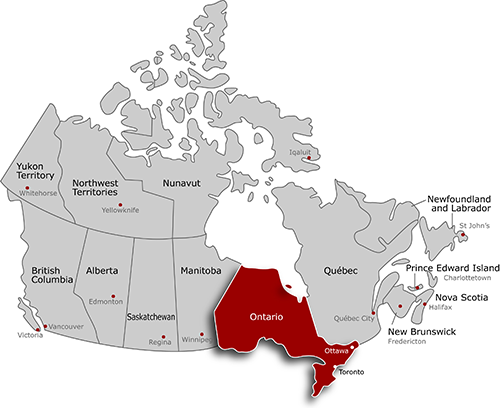|
Home > Ontario
 Toronto, Ontario Introduction to OntarioOntario (ON) is the province with the highest population and second largest total area in Canada. Some people confuse the province’s capital city, Toronto (which is also Canada's largest city) with Canada’s capital, which is Ottawa, Ontario. About 80% of Ontario’s population lives in the southern part of the province. Ontario's varied landscape includes the Canadian Shield across its centre. There is fertile farmland (Niagara Fruit Belt) in the south and the grassy lowlands in the north. The province has over 250,000 lakes, about a third of the world's fresh water. The economy in northern Ontario is based on natural resources (forestry, mining) while southern Ontario is heavily industrialized. Ontario is one of the four provinces that established the Dominion of Canada (British North America Act) on July 1, 1867. AreasEastAthens District Georgian BayGreater Toronto Area (GTA)KawarthaMuskokaNiagaraCities, Towns & CommunitiesCentral(Includes Georgian Triangle, Haliburton County, & Muskoka Alliston Georgian TriangleBarrie Haliburton HighlandsAlgonquin Highlands MuskokaBala EastAlmonte NorthAtikokan SouthAylmer Greater Toronto Area (GTA)Ajax Toronto CommunitiesAgincourt Niagara PeninsulaBeamsville ParksNP: National Parks
Ontario TriviaFlag Nicknames Provincial slogans License plate slogans News Other resources Interests in ON: Accommodation | Arts & Culture | Eat & Drink | Products & Services | Things to Do Ontario FactsDate ON entered confederationJuly 1, 1867 Area of ON1,076,395 sq km (415,598 sq miles) TopographyOntario is made up of Canadian Shield, borders on four of the five Great Lakes. It has 177,398 sq km (68,490 sq miles) made up of 250,000 lakes (one third of the world's fresh water) Capital city of ONToronto Population of ON14,223,942(Statistics Canada, 2021 Census) Residents are known asOntarians Indigenous people of ONSix Nations, Ontario First Nations Map Main ON industriesManufacturing and service sectors ON statutory holidays (in addition to national holidays)Family Day (third Monday in February) Professional sports teamsHamilton Tiger Cats (football)  Source: Government of Canada Maps ClimateMost of Ontario has hot humid summers with tropical-like thunderstorms and cold winters. In the Great Lakes region, there is a snow belt that receives up to 3m (10ft) of snow during the winter. Northern Ontario is affected by arctic air. Time zoneMost of Ontario is on Eastern Standard Time (EST). Some of Western/Northern Ontario (for example, Kenora) is on Central Standard Time (CST). Owned and operated by Canadian Only Inc. Copyright 2000-2025 |








